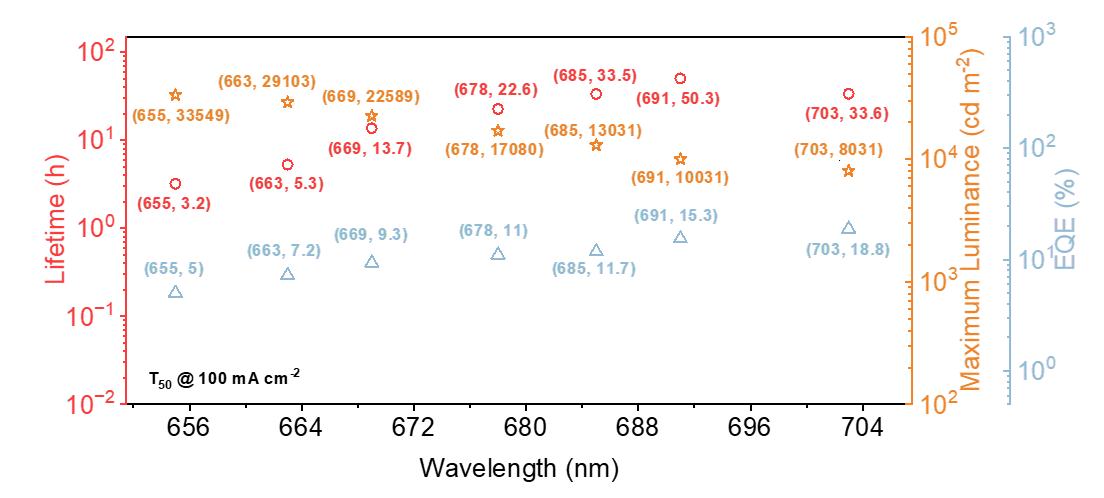What's on
Recently, the latest results of the perovskite luminescence research team of Zhejiang University were published online in Nature Photonics. The researchers proposed a material design idea of switching controllable zinc oxide/perovskite interface reaction, and made full use of zinc oxide/perovskite interface reaction to prepare high-quality CsPbI3 perovskite film. At the same time, the stability problem caused by continuous interface reaction is avoided, and the highest brightness and most stable solution method deep red LED device is realized. Corresponding authors are Academician Ye Zhizhen, Professor Jin Yizheng, and Dr. Liu Yang, Zhejiang University; The first authors are Zeng Jiejun and Sun Xiaoyue, PhD students of Zhejiang University.
Perovskite and perovskite LED (PeLED)
Metal halide perovskite materials have become the core materials of the new generation display technology due to their advantages of high defect tolerance, wavelength tunability and high external quantum efficiency. The efficiency of PeLED has developed rapidly in recent years, but the device stability is still far from sufficient. The development of high-performance PeLED prototype devices is a key step for PeLED to be applied in practice. The successful experience of quantum dot leds using ZnO transport layer provides a reference for the development of PeLED prototype devices, but there are still unresolved problems.
Zinc oxide/perovskite interface reaction: a double-edged sword
The interface reaction between perovskite and ZnO has been studied in perovskite solar cells: the alkaline ZnO layer will react with the organic cations in perovskite, which seriously affects the long-term stability of the device. While there are inevitable downsides, there are also upsides. During the crystallization process of perovskite, ZnO reacts with organic ammonium ions in the precursor/intermediate product, thus changing the crystallization kinetics of perovskite films and contributing to the formation of high-quality perovskite films.
Based on the above understanding, the research team envisaged to design a zinc oxide/perovskite interface, so that the interface reaction can be opened during the crystallization stage, and promote the formation of high-quality perovskite; After the end of the perovskite crystallization stage, the interface reaction is closed, so as to avoid the continuous reaction affecting the long-term stability of the perovskite, so as to prepare bright, efficient and long-life visible light PeLED.

Switch controllable interface reaction
Zinc oxide film is deposited by spinning coating of zinc oxide ammonia complex solution. The zinc (OH)2 film was formed when the complex was annealed at 60 ℃ to remove the complex ammonia. After annealing at 150 ℃, Zn(OH)2 is dehydrated to form a-ZnO, which is accompanied by the weakening of alkalescence and forms the basis of the switch controllable interface reaction.
The researchers found that the deprotonation reaction between the Zn(OH)2 substrate and the Gua+ ions in the GuaI-CsPbI3 perovskite precursor is critical for the formation of gamma-Cspbi3. The GuaI-CsPbI3 precursor was spin coated on Zn(OH)2 substrate and annealed. During subsequent annealing, the perovskite precursor reacts with the substrate to produce high-quality gamma-CSPbi3. It is worth noting that at the same time of annealing, in addition to the deprotonation reaction between Zn(OH)2 and Gua+ ions, it also gradually transformed into the weakly alkaline ZnO, which can no longer continue to seize the protons of Gua+ ions, and the interface deprotonation reaction is thus closed. The closure of interfacial deprotonation results in excellent material stability. This provides the basis for the subsequent preparation of PeLED devices.
PeLED device performance
Based on the above foundation, the researchers designed a novel device structure of SnO2/ZnO double layer electron transport layer, and successfully realized the high-performance PeLED device. The maximum brightness of the LED device reached 8030 cd m-2, creating a brightness record for CSPBI3-based LED; At 100 mA cm-2 constant current conditions, the half-decay life reached 33.6 hours, which also created the current life record of CSPBI3-based LED devices.
By replacing part of I with Br, the researchers also extended the reaction strategy to the mixed halogen CsPb(I/Br)3 system, successfully achieving PeLED covering the entire deep red wavelength with a maximum device lifetime of 50.3 h (at 100 mA cm-2 constant current). Set the highest brightness and stability record for solution process deep red LED.

Conclusion
The switch controllable reaction idea proposed in this work makes full use of the advantages of zinc oxide/perovskite interface deprotonation reaction to generate high-quality GuaI-CsPbI3 perovskite, while avoiding the stability problem caused by continuous interface reaction, and greatly improving the stability of perovskite materials and devices. This strategy also opens up new ideas for the design of new perovskite optoelectronic materials and devices.
Paper link: https://www.nature.com/articles/s41566-023-01369-9

